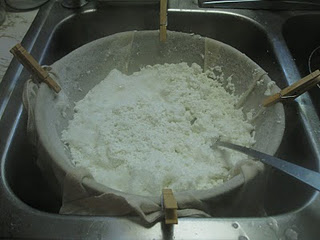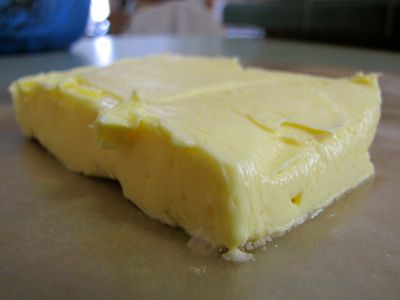Delicious and versatile Ricotta can be used in many recipes, but the way I make it, it can also be sliced and used in sandwiches, etc.

Pour milk into heavy bottomed kettle. Bring slowly up to almost boiling (at least 200 degrees F)
Add 1/2 cup vinegar. Remove from heat. Stir briefly. Let rest for 15 minutes.
Pour into colander lined with a cotton cloth. Gather up the corners of the cloth, and using a large spoon, press the whey from the cheese curds.
Turn the curds into a bowl and work in 1 teaspoon salt.
While it is still hot, I press the ricotta into a bowl,cover with plastic wrap and chill in the refrigerator.
When cold, it can be sliced or crumbled to use.
Wrap carefully to freeze. It keeps nicely for several months.
The most difficult part about making yogurt is keeping the temperature of the ferment stable and warm for a long enough period of time for the bacteria to do thier work. Using a crockpot as your fermentation vessle will make holding the temperature steady easier without the need for a yogurt maker.

Heat the milk to 185⁰F in a double boiler or in a heat proof bowl that snugly fits on top of pot of simmering water.
Remove the milk from the heat and let it cool to 105⁰-122⁰F. Placing your culture in milk that is too hot will kill the culture and milk that is too cool will not allow the reaction to occur.
Stir in the culture and place the yogurt into a glass container that has a tight fitting lid (I use pyrex dishes but I know others who use baby food jars). For store bought yogurt or homemade yogurt add ½ cup yogurt per 1 gallon of milk. If you are using cultures purchased from a cheese making supplier then follow the package instructions.
Set your jars in bottom of a slow cooker and fill with water and set it to “warm” setting. Be sure to keep a close eye on the temperature of the water.
Incubate the yogurt for 6-8 hours.
The trick is to keep the temperature of your yogurt between 98⁰ and 130⁰F. I have tried the crockpot method written above, but my “warm” setting was too hot. My solution was to turn the crockpot on low for 15 minutes. Then I turn the crockpot off and wrap in a towel and place it in a warm oven (preheated the oven to the lowest setting then turned it off and let it cool for 10 minutes before placing the yogurt in the oven). This method seems to give me the best results. You will have to play with the settings in your own home to come up with a solution that works best for you.
To stop the reaction, place your yogurt in the refrigerator. You can now flavor your yogurt with anything that you want. I like to add fruit and honey or fruit and maple syrup to mine.
Start with cultured cream to make a butter that is sweet and sour with complex, wonderful flavors.

Stir the culture into the cream. Cover the jar with a cloth napkin secured by a rubber band. Leave at room temperature for 24 hours. Then transfer to the refrigerator to chill.
Put the chilled cultured cream in a mixer, food processor, or blender. (Don’t use a Vita-Mix or the mixture will heat up.) Whatever your container is, fill it it to less than half because the cream will expand during the churning.
Turn on the machine. The process of churning may take between 5 and 10 minutes. The cream will go through stages on its way to butter. First, it will expand its volume and become whipped cream. Then the butter solids will start to clump together and separate from the liquid (buttermilk). The whole mixture will appear grainy. Then the solids will clump together even more until you have big chunks of butter floating in buttermilk. Run machine just a minute or so more to complete the process of clumping the butter solids.
Put the butter solids in a bowl. Save the liquid buttermilk for soaking grains (unless it is stinky, which can happen if the cream got very sour).
Repeat with all the cream until all of it is converted into butter solids.
Add cold, clean water to the bowl and use a hard spoon to press and fold the butter into the sides of the bowl. The water will quickly turn clowdy as the remaining buttermilk releases from the butter solids.
Change the water repeatedly. Keep washing the butter until the water stays clear. When the water is clear, you have clean butter! The cleaner the butter, the longer it will last. The washing water isn’t true buttermilk as it is too watered down. It makes good water for animals or the compost.
Pour off the remaining water. Press and fold the butter more to release more water.
Mix in the sea salt.
Transfer the butter to some kind of mold, or you can just shape it into a log or chunks.
Wrap gently in natural wax paper or parchment paper. Put in additional wrappings if desired (to prevent off flavors or freezer burn). Refrigerate or freeze.


